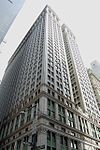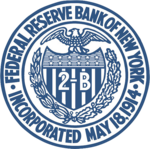Chamber of Commerce Building (Manhattan)

The Chamber of Commerce Building is a commercial building on 65 Liberty Street, between Liberty Place and Broadway, in the Financial District of Manhattan in New York City. Designed by architect James Barnes Baker, the four-story Beaux-Arts building was constructed between 1901 and 1902 as the first headquarters to be built specifically for the Chamber of Commerce of the State of New York. The structure is clad with Vermont marble and includes a rusticated masonry base, a short colonnade, and a copper mansard roof. The facade formerly contained statues of John Jay, Alexander Hamilton, and DeWitt Clinton, which had been designed by Daniel Chester French and Philip Martiny. The second story contained the Chamber of Commerce's Great Hall, hung with portraits of important individuals from American history. The rest of the building was largely devoted to offices or meeting rooms for the Chamber. Over the years, numerous stores and banks have rented out the ground story. The building's design was largely positively received upon its completion. The building was constructed after funds were raised from wealthy members of the Chamber of Commerce. Architects Helmle and Corbett remodeled the interior and built a new floor in 1922, resulting in changes to the mansard roof. French and Martiny's sculptures, installed in 1903, were removed in 1926 due to severe deterioration. After the Chamber of Commerce relocated to Midtown Manhattan in 1979, the building stood vacant for ten years. The International Commercial Bank of China bought the building in 1989 and the interior was subsequently renovated by Haines Lundberg Waehler. The Chamber of Commerce Building's design and scale was largely praised upon its completion. The building was designated a city landmark by the New York City Landmarks Preservation Commission in 1966 and was added to the National Register of Historic Places (NRHP) in 1973. The building also became a National Historic Landmark in 1977. It is a contributing property to the Wall Street Historic District, an NRHP district created in 2007.
Excerpt from the Wikipedia article Chamber of Commerce Building (Manhattan) (License: CC BY-SA 3.0, Authors, Images).Chamber of Commerce Building (Manhattan)
Liberty Street, New York Manhattan
Geographical coordinates (GPS) Address Nearby Places Show on map
Geographical coordinates (GPS)
| Latitude | Longitude |
|---|---|
| N 40.708888888889 ° | E -74.009722222222 ° |
Address
Liberty Street 59
10038 New York, Manhattan
New York, United States
Open on Google Maps









